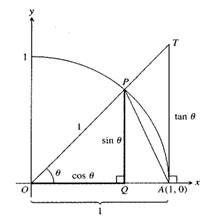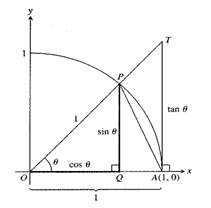
Concept explainers
(a)
To explain:The reason to restrict the interval
(a)
Explanation of Solution
Given information:The function is
For the right hand limit of given function check the points close to
The restrict interval to
(b)
To show:The area of
(b)
Explanation of Solution
Given information:The figure is given below:

Proof:
The formula for the area of triangle is given by,
In
In
The formula for the area of a sector with radius r is given by,
The radius of the sector is 1 with central angle
Hence, it is proved that area of
(c)
To show:The inequality
(c)
Explanation of Solution
Given information:The figure is given below:

Proof:
From part (b), it is proved that that area of
To prove the given inequality, compare the areas of
Also, the area of sector OAP contains under the region of
Now, compare inequality (1) and (2).
Hence, theinequality
(d)
To show:The inequality
(d)
Explanation of Solution
Proof:
From part (c), for the interval
Multiply the inequality by 2.
Divide the inequality by
Hence, theinequality proved in part (c) can be written as
(e)
To show:The inequality
(e)
Explanation of Solution
Proof:
From part (d), for the interval
Use the inverse property of inequality and take the inverse of each term to rewrite the inequality.
Hence, theinequality proved in part (d) can be written as
(f)
To show:The result
(f)
Explanation of Solution
Proof:
Sandwich theorem: If a function
From part (e), the condition for Sandwich theorem the inequality can be written as:
The limit of the function
The limit of the function 1 at
Now, by Sandwich theorem
Hence, theresult
(g)
To show:The function
(g)
Explanation of Solution
Given information: The function is
Proof:
Even function: If
Substitute
Hence, it is proved that
(g)
To show:The result
(g)
Explanation of Solution
Given information: The function is
Proof:
It is known that if a function is even function, then its graph is symmetric about the y -axis.
In part (f), it is already proved that the right-hand limit of the function at 0 is 1. From part (g), it is proved that that
The left hand limit is:
Hence, the result
(h)
To show:The result
(h)
Explanation of Solution
Given information: The function is
Proof:
If the left hand limit and right hand limit of a function is equal, then the limit at that point is the same as RHL or LHL.
In above parts it is already proved that at
Hence, the result
Chapter 2 Solutions
Calculus 2012 Student Edition (by Finney/Demana/Waits/Kennedy)
Additional Math Textbook Solutions
Precalculus: Concepts Through Functions, A Unit Circle Approach to Trigonometry (4th Edition)
University Calculus: Early Transcendentals (3rd Edition)
Calculus & Its Applications (14th Edition)
Thomas' Calculus: Early Transcendentals (14th Edition)
Single Variable Calculus: Early Transcendentals (2nd Edition) - Standalone book
Calculus and Its Applications (11th Edition)
 Calculus: Early TranscendentalsCalculusISBN:9781285741550Author:James StewartPublisher:Cengage Learning
Calculus: Early TranscendentalsCalculusISBN:9781285741550Author:James StewartPublisher:Cengage Learning Thomas' Calculus (14th Edition)CalculusISBN:9780134438986Author:Joel R. Hass, Christopher E. Heil, Maurice D. WeirPublisher:PEARSON
Thomas' Calculus (14th Edition)CalculusISBN:9780134438986Author:Joel R. Hass, Christopher E. Heil, Maurice D. WeirPublisher:PEARSON Calculus: Early Transcendentals (3rd Edition)CalculusISBN:9780134763644Author:William L. Briggs, Lyle Cochran, Bernard Gillett, Eric SchulzPublisher:PEARSON
Calculus: Early Transcendentals (3rd Edition)CalculusISBN:9780134763644Author:William L. Briggs, Lyle Cochran, Bernard Gillett, Eric SchulzPublisher:PEARSON Calculus: Early TranscendentalsCalculusISBN:9781319050740Author:Jon Rogawski, Colin Adams, Robert FranzosaPublisher:W. H. Freeman
Calculus: Early TranscendentalsCalculusISBN:9781319050740Author:Jon Rogawski, Colin Adams, Robert FranzosaPublisher:W. H. Freeman
 Calculus: Early Transcendental FunctionsCalculusISBN:9781337552516Author:Ron Larson, Bruce H. EdwardsPublisher:Cengage Learning
Calculus: Early Transcendental FunctionsCalculusISBN:9781337552516Author:Ron Larson, Bruce H. EdwardsPublisher:Cengage Learning





